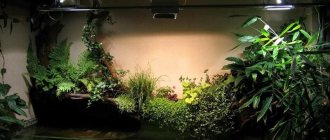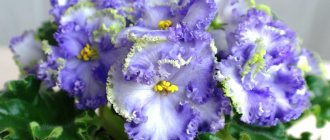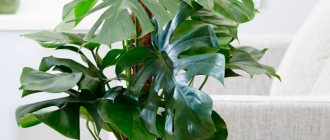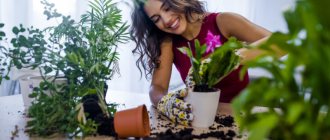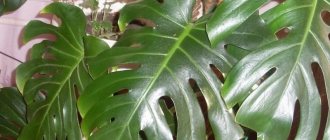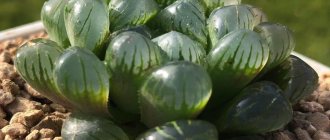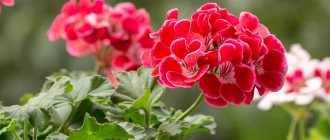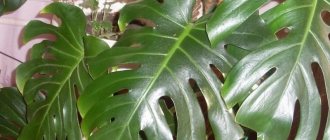The amount of light is a factor of paramount importance for flora. Shade-loving indoor plants are less demanding on lighting, which makes them indispensable in the interior. They remain decorative even with a lack of light, and easily transform dark corners of an apartment or office into green “oases.” The choice of potted plants for the hallway, bathroom, corridor, and rooms facing north should be especially careful. Read about which indoor plants require little light and what you should consider when caring for them.
General recommendations when choosing shade-loving plants
Almost all indoor flowers develop best in good light, but vary in their ability to tolerate bright sun and shade.
There are no plants that don't need light! It is a source of energy for photosynthesis, a “power button” for biorhythms and other processes in the body. But there are many representatives of the flora that are accustomed to living in conditions of significant shading.
Are the chosen plants suitable for your space or will they suffer from lack of light? Let's figure out what kind of lighting different indoor flowers require.
Light-loving, light-loving (heliophytes)
Such plants tolerate only a slight lack of sunlight. For normal growth and development, they require illumination of 1000–5000 lux (lx) and above. When illumination is below 700 lux, a period of rest begins. These include most succulents, citrus fruits, hippeastrum, zephyranthes, aechmea and many others.
Shade-loving or shady
In nature, such plants live in shady conditions - in the lower tier of the tropical forest, in the shade of large trees and shrubs. The leaves are relatively large, arranged horizontally, contain more chlorophyll and are able to photosynthesize in dim light.
Shade-loving indoor plants develop better in the shade and do not tolerate strong lighting from direct sunlight. This group includes some lianas, large-leaved begonias, and many commelinaceae.
Shade-tolerant (facultative heliophytes)
An intermediate group, including species that can grow in good light, in open shade, partial shade. There are quite a lot of them. These are some aroids, arrowroots, palms, chlorophytums and many other indoor flowers - moderately shade-tolerant, they require illumination of 400-500 lux (minimum 200, maximum 3000 lux).
Monstera, sansevieria, ivy and some other plants develop well in normal lighting conditions, but can also tolerate darkening. They are able to rearrange themselves under the influence of changes in the amount of light.
What plants can be kept in a bathroom without a window (full list)
- Aglaonema;
- Aspidistra tall;
- Begonia Royal;
- Dieffenbachia;
- Dracaena Sandera;
- Zamioculcas;
- Calathea;
- Mosses;
- Nephrolepis sublime;
- Orchids;
- Ferns;
- Peperomia obtufolia;
- Plownock;
- Plectranthus;
- Ivy;
- Sansevieria three-lane;
- Syngonium pedifolia;
- Spathiphyllum;
- Phalaenopsis orchid;
- Philodendron climbing;
- Chlorophytum crested;
- Cyperus;
- Epipremnum aureus.
In this article we tried to talk about which plants can be kept in a bathroom without a window. We hope you found it useful. If you have anything to add or want to share your experience, write in the comments. Don't forget to share the information with your friends!
Post Views: 21
Decorative foliage shade-loving plants
Gardeners are familiar with the names of shade-loving indoor plants. These are popular and in demand decorative deciduous crops.
If there is no desire or need to remember the names, then it is enough to remember a practical tip: plants with dark green flat leaves usually cope better than others with a lack of light.
The bright green color is the result of high chlorophyll content. The darker the leaves, the less they need bright light for photosynthesis, the darker the possible location. The most shade-tolerant indoor plants are placed 2 m from northern ones, 3 m from windows of a different orientation. They are suitable for creating green walls and corners in living rooms, halls, and offices.
Alocasia
Alocasia is a plant of the Araceae family. The popular name is “elephant ear”. Characteristic features of the flower: dense leaves, bright veins, long succulent petioles.
The flowers are small, inconspicuous, and appear rarely. Alocasia is not demanding both in terms of lighting conditions and care. The species A. copper-red and A. amazonica require additional lighting in winter.
Aucuba japonica
The plant received the popular name golden tree due to its shiny, leathery leaves. Aucuba grows well in partial shade and in diffused bright light. Green-leaved forms are shade-loving and resistant to changes in air temperature.
Shady places are not suitable for varieties with variegated foliage; they lose their characteristic pattern.
Aglaonema
Aglaonema modestus is a plant similar to Dieffenbachia, but smaller in size. The leaves are green or with multi-colored stripes and spots, with a clearly visible midrib.
Species and varieties with pure green leaves are the most shade-tolerant. They grow well indoors. Plants with variegated leaves need bright, indirect light.
Royal Begonia or Rex
It’s hard not to pay attention to this spectacular indoor plant with large leaves and a fantasy pattern. The leaf blades are asymmetrical and shaped like a heart.
The color above is silver-green, olive, below - purple, violet, dark pink. The dots and strokes are white or silvery. In a bright place, protected from direct sunlight, Rex begonia grows as a compact bush and stretches out in the shade.
Gemaria
Gemaria versicolor or Ludisia is an orchid with decorative leaves. The shape of the leaf blades is oval, the color is green-brown with white or silver veins.
The lower surface is red. Small yellow-white flowers bloom at the tops of the shoots. Gemaria is valued more for the beauty of its leaves than for its blooms. The plant feels great on the windowsill of a north window. In winter, it is advisable to supplement the light with a phytolamp.
Dracaena
Plants are valued for their exotic appearance and the beauty of their lush rosette of leaves. There are a large number of species with green leaves, such as Dracaena marginata. If you look closely, you will notice that the coloring is not the same. There is a thin red stripe along the edge of the leaves.
Dracaenas with solid green leaves are especially suitable for partial shade. However, the beautiful white, yellow, and red stripes of variegated varieties look more expressive in diffused bright light. Dracaena fragrant (Fragrans) can grow in partial shade. In a green corner, dracaenas are harmoniously combined in appearance and care requirements with chlorophytums, dieffenbachia, and palm trees. These plants require similar lighting conditions.
Maranthaceae
The group includes 4 species of plants: Maranta, Calathea, Stromantha and Ctenanta. They are true tropical beauties with variegated leaves. The plates have silvery or red veins. The lower surface of the leaves is purple, burgundy or violet.
Maranths look spectacular in semi-shaded corners of rooms, on the windowsills of northern windows, and under artificial lighting. Velvety leaves do not tolerate direct sunlight.
Fern phyllitis
An exotic plant suitable for living rooms, bedrooms and bathrooms. All types of ferns in nature and indoor culture have a common feature - they do not bloom. The natural habitat of these representatives of the flora is shady places under trees, on trunks. Phyllitis or Leaflet differs from many other ferns in its entire fronds (leaves). Forms with a wavy edge of the leaf blade were created.
The plant is kept in a shady place, for example, on the windowsill of a north window. Other indoor ferns are also resistant to lack of light: nephrolepis, long-leaved bracken.
Sansevieria
A houseplant with tough, striped leaves thrives in a shady location. Sansevieria looks decorative all year round, rarely gets sick and is practically not damaged by pests. The plant can reach a height of 1–1.5 m, so it is planted in wide, stable floor flowerpots or containers.
Low-growing varieties are more demanding and require a bright location. The brighter the stripes, spots and borders on the leaves of Sansevieria, the more light the plant requires.
Ficus dwarf
Tolerant of low light, fast-growing indoor flowers are ideal for rooms with artificial lighting. Ficus ampelous dwarf - a group of plants for the hallway. There are green-leaved and variegated varieties, and cultivated forms with wavy leaves.
Although dwarf ficus is considered shade-tolerant, modern variegated varieties require a little more light. When shaded, bright stripes and spots fade. But hanging ficuses can be content with artificial lighting.
Zamioculcas
A spectacular plant with long, thick branches and dense leaves, which is commonly called the dollar tree, grows well in partial shade.
The ideal place for this plant is a meter away from a south or south-east window. The flower also agrees with living on the northern, northeastern and northwestern windowsill. Zamioculcas even blooms in such conditions.
Monstera
The large plant attracts attention with its carved leaves, long aerial roots, and winding stem. Monstera does not tolerate the scorching sun, especially suitable for shady places.
Compact, variegated varieties of this crop are popular: “Borziga”, “Variegata”, “Alba”. Monsteras with variegated leaves are more sensitive to lack of light. In the shade, white, silver or golden spots disappear.
Chlorophytum
The plant is considered shade-loving, one of the most stable, unpretentious to living conditions.
The long narrow leaves of chlorophytum tolerate partial shade and bright light. In the second case, you need to take care of regular watering. An indoor flower in good conditions grows quickly, shoots out arrows with small white flowers and daughter rosettes. Chlorophytum looks especially attractive on a shelf and in a hanging pot.
Hamedorea
The indoor plant is considered the best among palm trees for placement in a house or apartment. Hamedorea is an elegant multi-stemmed shrub 1–1.5 m high. The shoots are beautifully curved, evenly leafy.
The entire shrub seems openwork thanks to the luxurious feathery leaves. The male inflorescences resemble mimosa. After pollination, small black fruits form on the red peduncles of female flowers. In nature, chamedorea grows in the shade of large trees, so it likes diffused light.
Fittonia
The attractive flower is one of the capricious houseplants. Fittonia is difficult to please in terms of lighting and moisture. Sissy grows better in paludariums, phytoterrariums or florariums.
If there is not enough light or it is too bright, then Fittonia loses its bright color. The plant is more suited to places with good artificial lighting than to natural ones.
Violet
Indoor violet is a compact plant that is very popular among gardeners. It has a short stem with rounded leathery leaves covered with short hairs and collected in a basal rosette. The color of the leaves can be dark green, variegated or white. The flower grows actively for the first few years. The violet flowering period lasts all year round. The color of the flowers is varied: simple or double inflorescences have a pale pink, purple, lilac or burgundy hue. The plant is used in folk medicine to prepare remedies for atherosclerosis, rheumatism and bronchitis. Violet essential oil is used in the cosmetic industry. The flower is easy to care for and does not require special conditions for its development. She feels great on windows facing north or in the back of the room with a moderate amount of light.
Blooming shade-tolerant houseplants
When choosing flowering plants for the home, many people have to give preference to flowers that love shade or tolerate shade without problems. We present a brief description, names and photos of the most popular species that bloom profusely in low light conditions.
It should be remembered that flowering shade-tolerant plants do not form buds and flowers in the shade. They require diffused lighting or light shading.
Among this group there are species that bloom in November or December. Most begin flowering in spring or summer with long daylight hours. Before budding and during flowering, it is not recommended to move or rotate pots with plants.
Azalea
This flower is often called rhododendron. Azalea is considered one of the most beautiful indoor plants.
It likes cool places and blooms in the winter months. The flowers are double or simple, the petals are painted in delicate tones with a predominance of pink and salmon. Corollas can be red, purple, white and variegated. Azaleas require diffused light, without direct sunlight.
Vriesia
There is another variant of the name of the plant - “friesea”. The flower belongs to the group of epiphytic bromeliads. The leaves are collected in a rosette, the center of which looks like a bowl. Vriesia blooms once in a lifetime, but very impressively.
A spear-shaped inflorescence blooms on a long peduncle. The bracts are brightly colored. They can be red, yellow, orange, two or three colors. Vriesia prefers places with diffused lighting. Completely shaded or too sunny locations are not suitable.
Calceolaria
This amazing, original house plant resembles an orchid with its bold colors. Calceolaria prefers cool rooms, feels good in diffused light, in openwork shade.
Often the flower is grown as an annual. In the first year the flowering is abundant, but in the subsequent season the decorative effect decreases. It is possible to extend the “age” of Calceolaria by ensuring it is kept cool in a bright place.
Clivia cinnabar
An easy to care for houseplant with large, bright flowers. Clivia's narrow, dark green leaves form a fan-shaped rosette. The flower arrow appears in mid or late February. At the top of the green “tube” a dense racemose inflorescence blooms. The flowers are funnel-shaped and colored in red-orange tones.
Clivia prefers bright, diffused light. The bush does not lose its decorative appearance in the shade, but then it blooms less often.
Lady's slipper orchid
The scientific name of this genus of orchids is paphiopedilum, which means “slipper.” Flowers bloom on peduncles up to 60 cm high.
P. appletona is considered shade-tolerant and comes from Southeast Asia. The leaves of Lady's slipper are narrow and long, bright green with a marbled pattern. The flowers are large (up to 10 cm), with a corolla decorated with lilac-violet dots and strokes. To flower, the plant requires diffused lighting, 12 hours of daylight.
Saintpaulia
Violet fits perfectly into the interior of a bedroom, kitchen, or office. The correct name of the plant is Saintpaulia violetflower. Small bushes bloom profusely almost all year round (with interruptions).
Violet loves light, but does not tolerate direct rays. The sun leaves burns on the velvet leaves, shortening the flowering period and life of the plant. Saintpaulia is suitable for diffused lighting on the windowsill of windows facing east and north-west.
Spathiphyllum
Spathiphyllum forms an inflorescence-cob surrounded by a bract leaf. Beautiful appearance and low maintenance requirements are the main reasons for the popularity of this plant.
Shade-loving flowers feel comfortable on northern, eastern or western windows. In summer, at midday, it is necessary to protect the leaves from direct sunlight. Spathiphyllum is ideal for shady corners of the house and bathrooms.
Streptocarpus
An unpretentious plant that blooms in the room belongs to the Gesneriaceae family. Streptocarpus is distinguished by the fact that it forms numerous flower stalks. In one specimen the number of buds and flowers reaches 100 or more.
The varieties of Streptocarpus hybrid look the most decorative. The plant is a relative of violet and gloxinia, but is less demanding to care for. However, the flower is sensitive to direct rays, so shady places are suitable for it.
Phalaenopsis
Butterfly orchid (bot. Phalaenopsis) is the most famous representative of the Orchid family. The flowers look like large butterflies, descending on thin green stems.
Orchids are suitable for lighting from eastern or western windows. It is not recommended to place it on the windowsills of windows facing south. In summer, scorching rays literally burn the delicate tissues of plants.
Phalaenopsis is thermophilic, but after flowering during the dormant period, the temperature must be reduced to 18–21°C.
Eucharis
Shining white flowers on high stalks and large leaves give the plant a festive look. Eucharis is considered a fastidious indoor plant; it requires attention and care. The flowering of the plant depends on light and temperature. The leaves are vulnerable to direct sun and can get burned. Eucharis prefers soft, light partial shade throughout the year.
In summer, the plant should be removed from windows, and in autumn it can be returned closer to a source of natural light. Eucharis requires 12 hours of daylight to flower.
Sansevieria
It is an evergreen houseplant that does not have a stem. The tough, erect stems grow straight from the ground and reach a length of about one meter. The leaf blade has a variegated or plain color. With proper care, Sansevieria blooms once a year with small, white flowers with a light vanilla aroma. It grows wild in the tropical forests of South Africa. Sansevieria is also known as "mother-in-law's tongue" or "pike tail". At home, it tolerates shading well. To prevent the flower from slowing down, it is moved to a well-lit room several times a year.
Shade-tolerant vines and ampels
Climbing, shade-loving and shade-tolerant plants look very attractive in hanging baskets, planters and baskets. Asparagus pleases with its bright openwork foliage, chlorophytum cheerfully produces “babies”, striped zebrins flash.
Assortment of hanging plants for dark rooms:
- Tradescantia;
- plectranthus;
- chlorophytums;
- asparagus;
- ivies.
This group of plants is suitable for rooms with artificial lighting and northern windows. When choosing hanging types, pay attention to the general pattern. Indoor flowers with monochrome leaves are more shade-tolerant than variegated ones.
Common indoor ivy
A house flower with leathery green leaves can be grown in the bathroom. It should be taken into account that a lot of water evaporates during showering and bathing. Therefore, the humidity in the room is higher than in other rooms.
Ivy loves warmth and moisture, tolerates shading, and adapts to artificial lighting. Hanging, densely leafy shoots look great on high shelves or in hanging plant pots.
Syngonium
Species of the genus Syngonium are distributed in the tropics and subtropics of America. These are large vines, usually growing as one long shoot. Modern hybrids differ in their type of growth - they are more compact, in the form of bushes or ampels.
Syngonium with monochromatic green leaves is more shade-tolerant. Variegated varieties are partially shade-tolerant.
Philodendron
The green climbing plant has heart-shaped leaves and tolerates low light in the corners of the room. Partial shade on a wall next to or opposite a window is an ideal place for a philodendron.
Philodendron can be grown in the kitchen, bathroom. Leaves purify and disinfect the air, trap gases that are released when burning gas or coal.
Asparagus
Most asparagus species prefer diffused light and cannot tolerate direct rays. They are highly decorative due to their delicate greenery and creeping shoots. It is convenient to grow asparagus in hanging baskets, attaching them to the wall.
Considering that in the autumn-winter period the flower needs rare watering, placing it on the wall does not cause any special problems.
Philodendron
The plant is an epiphyte, clinging to any support with its aerial roots. There are more than 900 species of philodendron.
Its leaves come in different shapes and colors. The upper ones are darker than the lower ones.
Philodendrons are decorations for spacious rooms, suitable for vertical gardening of large surfaces. You can choose an ampel type and place it in a flowerpot. There are varieties that require support; here you can use your imagination for decoration and create an unusual composition.
Caring for philodendron is very simple. He does not like drafts, bright direct rays, dry air and temperature changes. Spray and water generously in hot weather and moderately in winter. If not properly cared for, the flower will produce small leaves. In this case, you need to check the soil for stagnant water and add illumination with fluorescent lamps.
Loving shade and living in an aquarium
High humidity and lack of light are not the most pleasant conditions for most plants. The exception is a small group of species that live on the banks of water bodies or half in the water.
Caladium
The plant is valued for the beauty of its leaves - plain and variegated, combining shades of green, white, yellow, and purple. The tuber overwinters in the soil, the above-ground part “falls asleep.” Beautiful leaves appear in the spring and last only until early autumn. In this case, the plant requires high humidity, heat and diffused light.
Caladium is placed in partial shade, preferably in moist peat. The plant is moisture-loving, so it feels good in the bathroom.
Cryptanthus
A flower with a luxurious rosette of brightly colored leaves is not easy to grow, like all Bromeliads. Although some people think that Cryptanthus is similar to Sansevieria, some of its species have the same expressive stripes on the leaf blades. However, bromeliads are more demanding of location and humidity and grow better in greenhouses and florariums.
The flower requires shady or artificially lit locations. The wide, star-shaped, colorful rosettes are the most shade-loving of all bromeliads.
Siderasis brownish
Another plant with leaves collected in a rosette, distinguished by silver stripes on a dark green background and brown hairiness. In nature, siderasis grows in shady, moist forests and craves the same atmosphere in indoor conditions.
It is better to keep it in an aquarium or florarium with high walls, where you can create a wet greenhouse.
Cyperus
The marsh plant Cyperus is tolerant of light. The main thing for him is high humidity. This is an unpretentious indoor flower that is ready to adapt to a small amount of light.
Cyperus grows well in artificial light, which allows it to be placed in a hallway or bathroom, in a tray of water or an aquarium.
Fern
An ancient plant that has preserved its appearance since the era of dinosaurs. Grows in the forests of Eurasia and North America. This is a lush bush with leaves of light green color, openwork, carved, similar to a bird’s feather. Popular types of ferns in home gardening include nephrolepis and asplenium. In nature, the fern is located in the shade of trees, so at home it can be placed in any place except a brightly lit one. Well suited for growing on stands and shelves.
The condition of the bush can determine the air quality in the room. If it begins to wither, it means the air is very dry or contaminated with impurities and dust. Water the plant sparingly when the top layer dries out. Keep the soil slightly moist but not waterlogged.
The main thing in caring for shade-tolerant flowers
When choosing an assortment of indoor flowers for your home or office, you need to remember: indoor lighting is not the same as outdoor lighting. Glass reflects and absorbs almost 50% of daylight. Right next to the window, the level of illumination on a sunny day is 3 times less than outside. The sun's rays hardly penetrate into the northern windows. The luminous flux is reduced by buildings and trees opposite the windows, which provide shade.
Quantity of light:
- outdoors - from 10,000 to 100,000 lux;
- brightly lit indoor locations (right next to the window) - from 3000 to 2000 lux; partial shade (at a distance from 1 to 1.5 m from the windows) - from 2000 to 1000 lux; the sun illuminates at least 4 hours a day;
- shaded (not sunlight, but only diffused light, 2-3 meters from the window) - from 1000 to 500 lux;
- complete shade - almost no daylight.
The great advantage of shade-loving and shade-tolerant plants is that they tolerate low light and look good with little care. These indoor flowers evaporate less water than light-loving species, so they can go without watering for a week or two (moisture-loving aquarium flowers are not included in this list). Plants from the second and third groups do not lose their decorative properties in low light (less than 500 lux). However, a dark hallway or other unlit room is not suitable.
The length of daylight hours is also important. Tropical plants in nature are illuminated 10–12 hours a day all year round. In temperate latitudes, daylight hours in winter last only 7–8 hours. Therefore, additional lighting is required from November to February or March. Shade-loving plants suffer no less from lack of light in winter than heliophytes. Therefore, it is recommended to place them in the autumn-winter period closer to the windows or provide additional lighting.
Pests must be controlled
When wiping the leaves of shade-tolerant indoor plants from dust, you need to carefully inspect them for the presence of pests. For large-leaved plants, the dangers are: spider mites and aphids.
Cobwebs on the back of the leaves indicate that the plant is infested with spider mites. This disease will cause leaves to fall off. Therefore, it is necessary to combat this pest. If wiping the leaves does not help, insecticides must be applied. To prevent spider mite damage to plants, air humidifiers or constant spraying of leaves are best suited. Because it is dry air that can cause plants to be affected by this disease.
If you carefully care for plants, they will delight everyone with their beauty and help maintain a good climate in the house.
